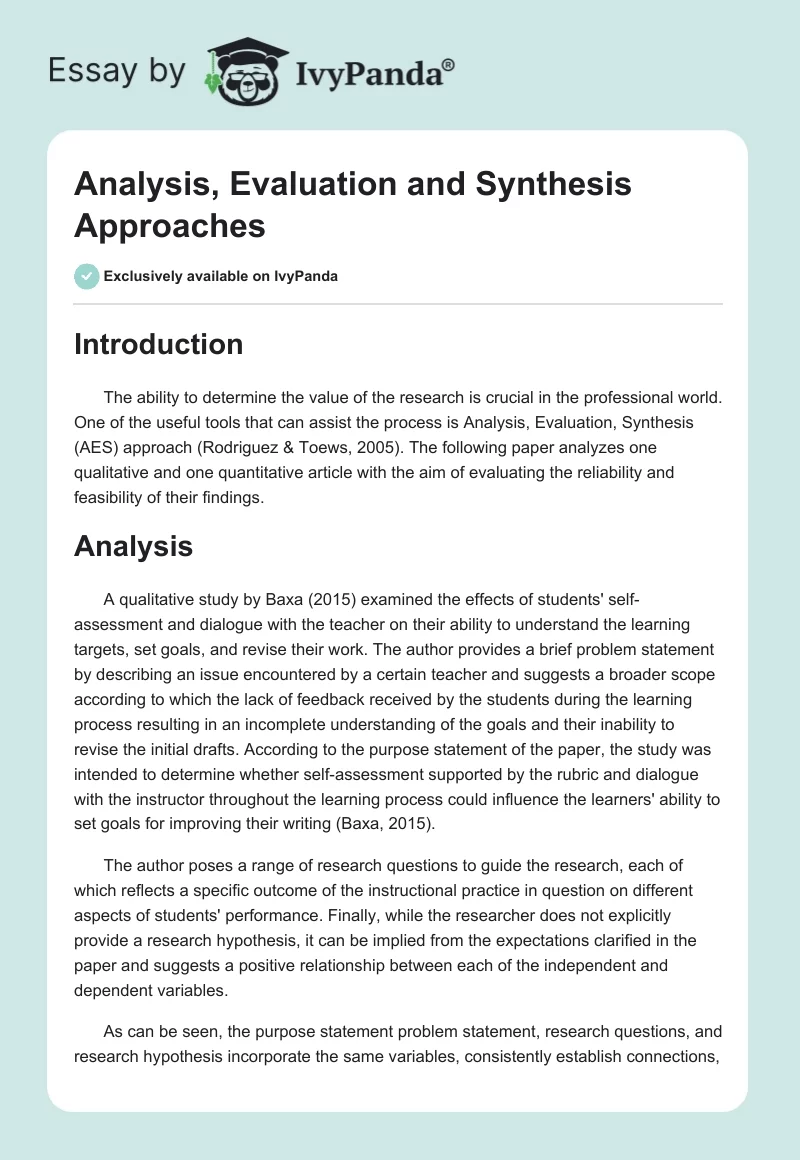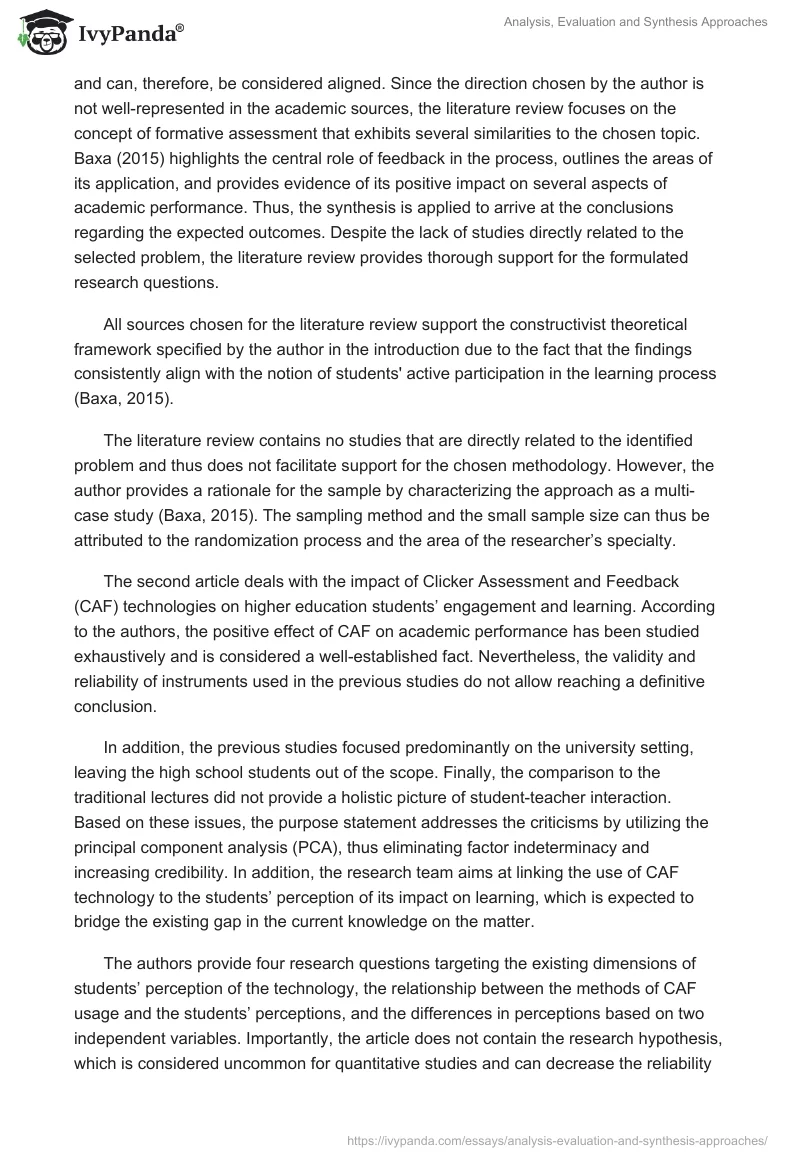Introduction
The ability to determine the value of the research is crucial in the professional world. One of the useful tools that can assist the process is Analysis, Evaluation, Synthesis (AES) approach (Rodriguez & Toews, 2005). The following paper analyzes one qualitative and one quantitative article with the aim of evaluating the reliability and feasibility of their findings.
Analysis
A qualitative study by Baxa (2015) examined the effects of students’ self-assessment and dialogue with the teacher on their ability to understand the learning targets, set goals, and revise their work. The author provides a brief problem statement by describing an issue encountered by a certain teacher and suggests a broader scope according to which the lack of feedback received by the students during the learning process resulting in an incomplete understanding of the goals and their inability to revise the initial drafts. According to the purpose statement of the paper, the study was intended to determine whether self-assessment supported by the rubric and dialogue with the instructor throughout the learning process could influence the learners’ ability to set goals for improving their writing (Baxa, 2015).
The author poses a range of research questions to guide the research, each of which reflects a specific outcome of the instructional practice in question on different aspects of students’ performance. Finally, while the researcher does not explicitly provide a research hypothesis, it can be implied from the expectations clarified in the paper and suggests a positive relationship between each of the independent and dependent variables.
As can be seen, the purpose statement problem statement, research questions, and research hypothesis incorporate the same variables, consistently establish connections, and can, therefore, be considered aligned. Since the direction chosen by the author is not well-represented in the academic sources, the literature review focuses on the concept of formative assessment that exhibits several similarities to the chosen topic. Baxa (2015) highlights the central role of feedback in the process, outlines the areas of its application, and provides evidence of its positive impact on several aspects of academic performance. Thus, the synthesis is applied to arrive at the conclusions regarding the expected outcomes. Despite the lack of studies directly related to the selected problem, the literature review provides thorough support for the formulated research questions.
All sources chosen for the literature review support the constructivist theoretical framework specified by the author in the introduction due to the fact that the findings consistently align with the notion of students’ active participation in the learning process (Baxa, 2015).
The literature review contains no studies that are directly related to the identified problem and thus does not facilitate support for the chosen methodology. However, the author provides a rationale for the sample by characterizing the approach as a multi-case study (Baxa, 2015). The sampling method and the small sample size can thus be attributed to the randomization process and the area of the researcher’s specialty.
The second article deals with the impact of Clicker Assessment and Feedback (CAF) technologies on higher education students’ engagement and learning. According to the authors, the positive effect of CAF on academic performance has been studied exhaustively and is considered a well-established fact. Nevertheless, the validity and reliability of instruments used in the previous studies do not allow reaching a definitive conclusion.
In addition, the previous studies focused predominantly on the university setting, leaving the high school students out of the scope. Finally, the comparison to the traditional lectures did not provide a holistic picture of student-teacher interaction. Based on these issues, the purpose statement addresses the criticisms by utilizing the principal component analysis (PCA), thus eliminating factor indeterminacy and increasing credibility. In addition, the research team aims at linking the use of CAF technology to the students’ perception of its impact on learning, which is expected to bridge the existing gap in the current knowledge on the matter.
The authors provide four research questions targeting the existing dimensions of students’ perception of the technology, the relationship between the methods of CAF usage and the students’ perceptions, and the differences in perceptions based on two independent variables. Importantly, the article does not contain the research hypothesis, which is considered uncommon for quantitative studies and can decrease the reliability of findings (Martella, Nelson, Morgan, & Marchand-Martella, 2013). Nevertheless, the research questions properly reflect the purpose statement and address the identified issues in the existing research.
The literature review provides a brief description of the history of CAF introduction and a summary of findings that confirm its usefulness in classrooms. In addition, it contains a comprehensive synthesis of the concerns voiced by the critics backed by the statistical analysis of the methods employed in the previous researches (Han & Finkelstein, 2013). Each of the concerns was supported with references from studies where it could be observed. Thus, the literature review is strongly aligned with the problem statement and demonstrates the synthesis through the detailed results of the statistical analysis of sources (Booth, Sutton, & Papaioannou, 2016).
The authors do not specify the theoretical framework of the study. However, the focus on active student participation as a crucial component of CAF’s success suggests the use of the constructivist framework (Fensham, Gunstone, & White, 2013). The sample used in the study consisted of 74 professors and 5459 students, all of whom were participants in the CAF development sessions (Han & Finkelstein, 2013). The data was collected via a questionnaire based on and modified after the previous CAF studies and supported with demographic data retrieved from the university’s course registration and information system (Han & Finkelstein, 2013).
SPSS 20.0 was used to conduct the analysis of the data. The chosen sample size, sampling method, and data analysis tool were relevant for the identified problems, connected to the research question, and aligned with the information derived from the literature review.
The assumptions and assertions made by the author of the qualitative article were made based on personal observations and confirmed by establishing the connections in the literature review. The authors of the quantitative article adopted assumed the validity of the criticisms voiced in the academic literature and verified it using the statistical analysis of sources in a literature review. The inferences in each case were valid and directly related to the methods selected for the study. With the exception of the lack of research hypotheses in the article by Han and Finkelstein (2013), all research components were appropriate within the given discipline.
The most significant insight that can be used during the development of the respective section of a dissertation was the use of statistical analysis as a means of confirmation of the alleged gaps in the existing research. Another valuable insight was the possibility to establish a connection to the marginally related fields of inquiry in the case where the directly related studies are scarce.
Conclusion
The analysis and evaluation provide ample evidence of the responsibly conducted research. In both papers, the authors properly aligned the purpose of the research and the respective questions and hypotheses with the identified problems and selected the methodological approaches that allowed for the appropriate responses to the questions. The literature reviews in both cases reflected the current knowledge on the matter. Thus, the findings of both research teams can be considered reliable and feasible for practical implementation.
References
Baxa, S. (2015). Enhancing students’ understanding and revision of narrative writing through self-assessment and dialogue: A qualitative multi-case study. The Qualitative Report, 20(10), 1682-1708. Web.
Booth, A., Sutton, A., & Papaioannou, D. (2016). Systematic approaches to a successful literature review (2nd ed.). New York NY: Sage. Web.
Fensham, P. J., Gunstone, R. F., & White, R. T. (Eds.). (2013). The content of science: A constructivist approach to its teaching and learning. New York, NY: Routledge. Web.
Han, J. H., & Finkelstein, A. (2013). Understanding the effects of professors’ pedagogical development with Clicker Assessment and Feedback technologies and the impact on students’ engagement and learning in higher education. Computers & Education, 65, 64-76. Web.
Martella, R. C., Nelson, J. R., Morgan, R. L., & Marchand-Martella, N. E. (2013). Understanding and interpreting educational research. New York, NY: Guilford Press. Web.
Rodriguez, A., & Toews, M. L. (2005). Training students to be better consumers of research: Evaluating empirical research reports. College Teaching, 53(3), 99-101. Web.


